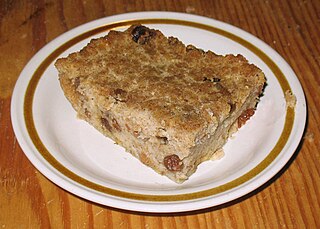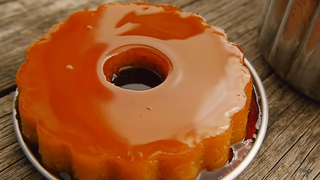
Herrencreme is a German pudding. It is a vanilla pudding mixed with cream and chocolate shavings and a good amount of rum. [1] Typically Herrencreme is a dessert eaten after a large meal, such as at a wedding.

Herrencreme is a German pudding. It is a vanilla pudding mixed with cream and chocolate shavings and a good amount of rum. [1] Typically Herrencreme is a dessert eaten after a large meal, such as at a wedding.

Yorkshire pudding is a common English side dish, a baked pudding made from a batter of eggs, flour, and milk or water. It is a versatile food that can be served in numerous ways depending on the choice of ingredients, the size of the pudding, and the accompanying components of the dish. As a first course, it can be served with onion gravy. For a main course, it may be served with beef and gravy, and is part of the traditional Sunday roast, but can also be filled with foods such as bangers and mash to make a meal. Sausages can be added to make toad in the hole.

Bread pudding is a bread-based dessert popular in many countries' cuisines, made with stale bread and milk or cream, generally containing eggs, a form of fat such as oil, butter or suet, and depending on whether the pudding is sweet or savory, a variety of other ingredients. Sweet bread puddings may use sugar, syrup, honey, dried fruit, nuts, as well as spices such as cinnamon, nutmeg, mace, or vanilla. The bread is soaked in the liquids, mixed with the other ingredients, and baked.

Pudding is a type of food that can be either a dessert or a savory dish that is part of the main meal.

Spotted dick is a traditional British baked pudding, historically made with suet and dried fruit and often served with custard.

Christmas pudding is a type of pudding traditionally served as part of the Christmas dinner in Britain, Ireland and in other countries where it has been brought by British and Irish immigrants. It has its origins in medieval England, and is sometimes known as plum pudding or just "pud", though this can also refer to other kinds of boiled pudding involving dried fruit. Despite the name "plum pudding", the pudding contains no actual plums due to the pre-Victorian use of the word "plums" as a term for raisins. The pudding has been heavily mythologized, including the erroneous idea that it is traditionally composed of thirteen ingredients, symbolizing Jesus and the Twelve Apostles, or that it was invented by George I of Great Britain. Early recipes include little more than suet, dried fruit, breadcrumbs, flour, eggs and spice, along with liquid which may be milk or fortified wine. Later recipes became more elaborate.

Bakewell pudding is an English dessert consisting of a flaky pastry base with a layer of sieved jam and topped with a filling made of egg and almond paste.

White pudding, oatmeal pudding or mealy pudding is a meat dish popular in Scotland, Ireland, Northumberland, Nova Scotia, and Newfoundland.

Rice pudding is a dish made from rice mixed with water or milk and other ingredients such as cinnamon, vanilla and raisins.

Chocolate puddings are a class of desserts with chocolate flavors. There are two main types: a boiled then chilled dessert, texturally a custard set with starch, commonly eaten in the U.S., Canada, Germany, Sweden, Poland, and East and South East Asia; and a steamed/baked version, texturally similar to cake, popular in the UK, Ireland, Australia, Germany and New Zealand.

The Hasty Pudding Theatricals, known informally simply as The Pudding, is a theatrical student society at Harvard University, known for its burlesque crossdressing musicals. The Hasty Pudding is the oldest theatrical organization in the United States and the third oldest in the world, behind only the Comédie-Française and the Oberammergau Passion Play. The Hasty Pudding Theatricals was described by John Wheelwright in 1897 as a "kindly association of men of all ages in a gay evening of simple enjoyment." It is a comedy show.

Pease pudding, also known as pease porridge, is a savoury pudding dish made of boiled legumes, typically split yellow peas, with water, salt, and spices, and often cooked with a bacon or ham joint. A common dish in the north-east of England, it is consumed to a lesser extent in the rest of Britain, as well as in other regions worldwide.

Sticky toffee pudding, also known as sticky date pudding in Australia and New Zealand, is an English dessert consisting of a very moist sponge cake, made with finely chopped dates, covered in a toffee sauce and often served with a vanilla custard or vanilla ice-cream. It is considered a British classic by various culinary experts, alongside bread and butter pudding, jam roly-poly and spotted dick puddings.

Sussex pond pudding, or well pudding, is a traditional English pudding from the southern county of Sussex. It is made of a suet pastry, filled with butter and sugar, and is boiled or steamed for several hours. Modern versions of the recipe often include a whole lemon enclosed in the pastry. The dish is first recorded in Hannah Woolley's 1672 book The Queen-Like Closet.

Sago pudding is a sweet pudding made by boiling sago with either water or milk and adding sugar and sometimes additional flavourings. It is made in many cultures with varying styles, and may be produced in a variety of ways. Southeast Asia, especially Indonesia and Malaysia, produces the majority of sago.

Black pudding is a distinct regional type of blood sausage originating in Great Britain and Ireland. It is made from pork or beef blood, with pork fat or beef suet, and a cereal, usually oatmeal, oat groats or barley groats. The high proportion of cereal, along with the use of certain herbs such as pennyroyal, serves to distinguish black pudding from blood sausages eaten in other parts of the world.

Muhallebi is a milk pudding that has legendary origins dating to Sassanid Persia (224-651). Most commonly made with rice, sugar, rice flour and milk, it can also be made with semolina. The dessert is popular in Turkey, Syria, Israel, Lebanon, Iraq and other Middle Eastern countries.
| Wikimedia Commons has media related to Herrencreme . |